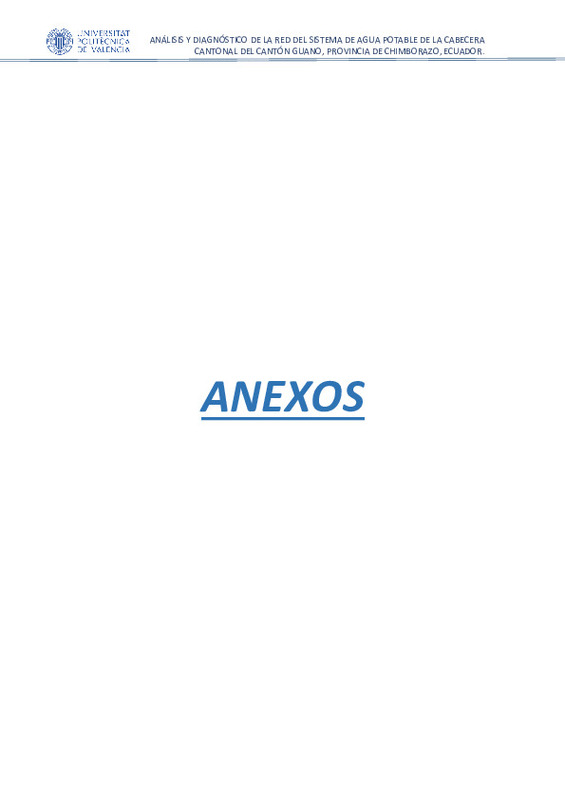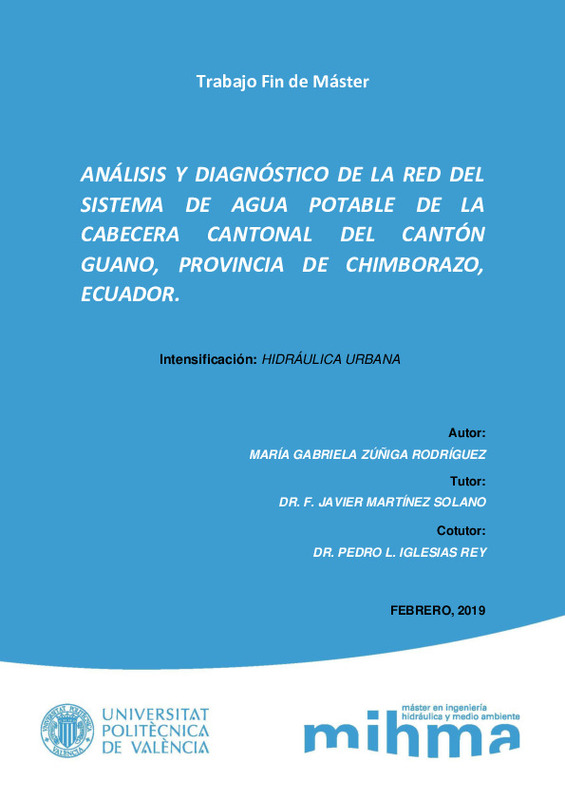JavaScript is disabled for your browser. Some features of this site may not work without it.
Buscar en RiuNet
Listar
Mi cuenta
Estadísticas
Ayuda RiuNet
Admin. UPV
Análisis y diagnóstico de la red del sistema de Agua Potable de la cabecera cantonal del Cantón Guano, Provincia de Chimborazo, Ecuador
Mostrar el registro sencillo del ítem
Ficheros en el ítem
| dc.contributor.advisor | Martínez Solano, Francisco Javier
|
es_ES |
| dc.contributor.advisor | Iglesias Rey, Pedro Luis
|
es_ES |
| dc.contributor.author | Zúñiga Rodríguez, María Gabriela
|
es_ES |
| dc.coverage.spatial | east=-78.65432550000003; north=-1.6647995; name=Argentinos 3564, Riobamba, Equador | es_ES |
| dc.date.accessioned | 2019-04-01T14:00:48Z | |
| dc.date.available | 2019-04-01T14:00:48Z | |
| dc.date.created | 2019-02-26 | |
| dc.date.issued | 2019-04-01 | es_ES |
| dc.identifier.uri | http://hdl.handle.net/10251/118836 | |
| dc.description.abstract | [ES] El Cantón Guano se localiza en el centro del Altiplano Andino del Ecuador, al norte de la provincia de Chimborazo. La cabecera cantonal se asienta sobre los 2720 m.s.n.m., posee un clima templado con una media de 18°C. Para el año 2018 se determina una población aproximada de 11.500 habitantes en base a los datos obtenidos del catastro urbano del municipio de la localidad. El sistema actual de agua potable fue construido hace más de 50 años, el mismo que ha sido ampliado y mejorado en varias ocasiones por parte de la jefatura de agua potable de la municipalidad. El agua de suministro proviene de los glaciares del nevado Chimborazo, es captada desde 3 distintas vertientes superficiales ubicadas a una altura promedio de los 3000 msnm. Debido a la topografía montañosa del sector, la conducción hacia los tanques reservorios y la de distribución del sistema se realiza por gravedad. Existen dos conducciones, la conducción principal tiene una longitud de 7.84 km y llega hasta el tanque reservorio desde el que se realiza la distribución principal a la ciudad y la conducción secundaria de 6.57 km que abastece a los barrios altos de la ciudad. La conducción del sistema está construida con tubería de PVC entre una gama de diámetros de 110 mm, 160mm, 200 mm y 250mm. El sistema se compone por 3 tanques reservorios, cada uno de ellos distribuye el agua hacia las partes alta, media y baja de la población, respectivamente. La red de distribución de agua potable está conformada por 30 km de tubería, con diámetros desde 63 mm, 90mm, 110mm, 160mm y 200mm, el material de la tubería de la red de distribución es de PVC. El servicio de agua potable en la zona de estudio es continuo, es decir los habitantes tienen disponible las 24 horas del día. La normativa vigente en el país establece que la presión mínima debe ser mayor a los 10 mca y la presión máxima dinámica no debe ser superior a los 50 mca. Se evidencia en el modelo matemático que un 21% de presiones se encuentran bajo el límite permitido y un 38% superan el límite máximo. Datos que han sido corroborados mediante pruebas de campo realizadas en las zonas afectadas. Esta problemática de presiones genera graves daños al sistema. Las altas y bajas presiones en el suministro de agua influyen en el deterioro de la red, en la cantidad de agua fugada así como en la calidad de la misma. Se realizará la estimación de fugas de la red para incluirlas en el modelo matemático. La red cuenta con pocas válvulas de regulación distribuidas a lo largo del sistema, las cuales no se encuentran en funcionamiento. De igual manera las válvulas de seccionamiento debido a su mal estado, provocan que al momento de producirse alguna avería, el servicio de agua sea suspendido en su totalidad para atender las reparaciones de la red. La tarifa base del servicio de agua potable es de $ 2.87 mensuales, en tanto el costo promedio de la tarifa mensual que pagan los usuarios por el servicio de agua es de $3.35, siendo este un valor muy bajo para que el sistema de agua potable sea sostenible. La metodología que se plantea para la ejecución del trabajo es la siguiente: ¿ Análisis y diagnóstico usando el modelo matemático del sistema. ¿ Mejora del modelo matemático. ¿ Gestión de las presiones del sistema. ¿ Gestión de las velocidades. ¿ Sectorización de la red. ¿ Instalación de valvulería (reductoras y limitadoras) ¿ Estudio de la conducción del sistema (transitorio). ¿ Instalación y cambio de elementos del sistema. (tubería y válvulas). | es_ES |
| dc.description.abstract | [EN] Canton Guano is located in the center of the Andean Altiplano of Ecuador, north of the province of Chimborazo. The cantonal head sits on 2720 m.s., has a temperate climate with an average of 18 ° C. For the year 2018, an approximate population of 11,500 inhabitants is determined based on the data obtained from the urban cadastre of the municipality of the town. The current drinking water system was built more than 50 years ago, the same one that has been extended and improved several times by the municipality's drinking water headquarters. The supply water comes from the glaciers of the Chimborazo mountain, it is captured from 3 different surface slopes located at an average altitude of 3000 meters above sea level. Due to the mountainous topography of the sector, the conduction towards the reservoir tanks and the distribution of the system is done by gravity. There are two pipelines, the main conduit has a length of 7.84 km and reaches the reservoir tank from which the main distribution is made to the city and the secondary conduit of 6.57 km that supplies the upper districts of the city. The conduction of the system is constructed with PVC pipe between a range of diameters of 110 mm, 160 mm, 200 mm and 250 mm. The system consists of 3 reservoir tanks, each of which distributes the water to the upper, middle and lower parts of the population, respectively. The potable water distribution network is made up of 30 km of pipe, with diameters from 63 mm, 90 mm, 110 mm, 160 mm and 200 mm, the material of the distribution network pipe is made of PVC. The drinking water service in the study area is continuous, that is, the inhabitants are available 24 hours a day. The regulations in force in the country establish that the minimum pressure must be greater than 10 mca and the maximum dynamic pressure must not exceed 50 mca. It is evident in the mathematical model that 21% of pressures are below the allowed limit and 38% exceed the maximum limit. Data that have been corroborated by field tests carried out in the affected areas. This problem of pressures generates serious damage to the system. The high and low pressures in the water supply influence the deterioration of the network, the amount of water leaked as well as the quality of it. The leakage estimation of the network will be carried out to include them in the mathematical model. The network has few regulation valves distributed throughout the system, which are not in operation. Likewise, the isolating valves due to their poor condition, cause that at the time of any breakdown, the water service is suspended in its entirety to meet the repairs of the network. The base rate of the potable water service is $ 2.87 per month, while the average cost of the monthly fee paid by users for water service is $ 3.35, this being a very low value for the drinking water system to be sustainable. The methodology that is proposed for the execution of the work is the following: ¿ Analysis and diagnosis using the mathematical model of the system. ¿ Improvement of the mathematical model. ¿ Management of system pressures. ¿ Speed management. ¿ Sectorization of the network. ¿ Installation of valves (reducers and limiters) ¿ Study of the conduction of the system (transitory). ¿ Installation and change of system elements. (pipe and valves). | es_ES |
| dc.language | Español | es_ES |
| dc.publisher | Universitat Politècnica de València | es_ES |
| dc.rights | Reconocimiento - No comercial - Sin obra derivada (by-nc-nd) | es_ES |
| dc.subject | Conducción | es_ES |
| dc.subject | Red de abastecimiento | es_ES |
| dc.subject | Control de presiones | es_ES |
| dc.subject | EPANET. | es_ES |
| dc.subject | Conduction | es_ES |
| dc.subject | Water supply network | es_ES |
| dc.subject | Pressure control | es_ES |
| dc.subject.classification | MECANICA DE FLUIDOS | es_ES |
| dc.subject.other | Máster Universitario en Ingeniería Hidráulica y Medio Ambiente-Màster Universitari en Enginyeria Hidràulica i Medi Ambient | es_ES |
| dc.title | Análisis y diagnóstico de la red del sistema de Agua Potable de la cabecera cantonal del Cantón Guano, Provincia de Chimborazo, Ecuador | es_ES |
| dc.type | Tesis de máster | es_ES |
| dc.rights.accessRights | Abierto | es_ES |
| dc.contributor.affiliation | Universitat Politècnica de València. Departamento de Ingeniería Hidráulica y Medio Ambiente - Departament d'Enginyeria Hidràulica i Medi Ambient | es_ES |
| dc.description.bibliographicCitation | Zúñiga Rodríguez, MG. (2019). Análisis y diagnóstico de la red del sistema de Agua Potable de la cabecera cantonal del Cantón Guano, Provincia de Chimborazo, Ecuador. http://hdl.handle.net/10251/118836 | es_ES |
| dc.description.accrualMethod | TFGM | es_ES |
| dc.relation.pasarela | TFGM\97953 | es_ES |







